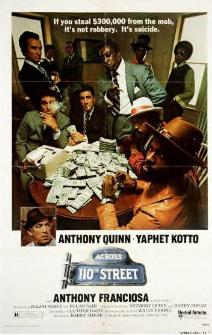Across 110th Street
| Across 110th Street | |
|---|---|

Theatrical poster
|
|
| Directed by | Barry Shear |
| Produced by | Anthony Quinn Fouad Said Barry Shear |
| Written by |
Novel: Wally Ferris Screenplay: Luther Davis |
| Starring |
Anthony Quinn Yaphet Kotto Anthony Franciosa |
| Music by |
Bobby Womack J. J. Johnson |
| Distributed by | United Artists |
|
Release date
|
|
|
Running time
|
102 minutes |
| Country | United States |
| Language | English |
| Box office | $10,000,000 |
| Across 110th Street Soundtrack | ||||
|---|---|---|---|---|
 |
||||
| Soundtrack album by Bobby Womack and J.J. Johnson | ||||
| Released | December 16, 1972 | |||
| Recorded | 1972 | |||
| Genre | R&B | |||
| Length | 30:13 | |||
| Label | United Artists | |||
| Producer | Bobby Womack | |||
| Bobby Womack and J.J. Johnson chronology | ||||
|
||||
| Professional ratings | |
|---|---|
| Review scores | |
| Source | Rating |
| Allmusic |
|
Across 110th Street is a 1972 American crime drama film starring Anthony Quinn, Yaphet Kotto, and Anthony Franciosa, and directed by Barry Shear. Commonly associated with the blaxploitation genre at the time, it has received considerable critical praise from writer Greil Marcus and others for surpassing the limitations of that genre.
This film is set in Harlem, of which 110th Street is an informal boundary line. By-the-book African-American Lieutenant William Pope (Kotto) has to work with crude, racist but streetwise Italian-American Captain Frank Mattelli (Quinn) in the NYPD's 27th precinct. They are looking for three black men who slaughtered seven men—three black gangsters and two Italian gangsters, as well as two patrol officers—in the robbery of $300,000 from a Mafia-owned Harlem policy bank. Mafia lieutenant Nick D'Salvio (Franciosa) and his two henchmen are also after the hoods. In one of many violent scenes, D'Salvio finds getaway driver Henry J. Jackson (Antonio Fargas) and brutalizes him in a Harlem whorehouse.
The movie was filmed on location in Harlem, New York. The film is also notable as being the first feature film to use a self-blimped camera (the Arriflex 35BL) for sync sound; the much-reduced size of the camera allowed the production to not only use more hand-held shots and smaller locations than normal, but also record usable sound at the same time - an endeavor not previously possible under those circumstances.
...
Wikipedia
